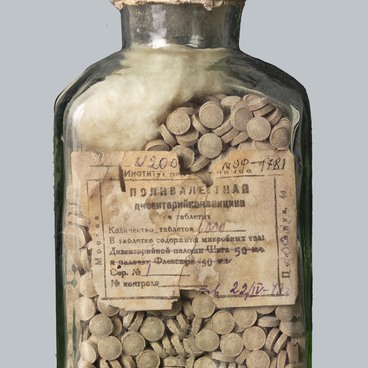During the Great Patriotic War, the Red Army’s Medical Corps worked to ensure military hygiene and epidemic control. The combat readiness of the soldiers was maintained by measures to purify and disinfect water, provide adequate nutrition, and prevent frostbite and infectious diseases.
The museum’s collection houses two glass vials with Pantocide tablets. Each has a label that reads, “Pantocide, pantozidum, series 66, made in December 1943.” The vials were sealed with a cork stopper, which was coated with paraffin. Each vial contains 20 tablets.
During the Great Patriotic War, soldiers used Pantocide to disinfect drinking water in their flasks. The product was adopted by the army in 1939. In field conditions, especially during battles, soldiers were forced to use water from untested sources, including rivers, ponds, and swamps. The problem was not to obtain water as such, but to make sure that the drinking water was clean.
The issue became especially acute when the enemy used weapons of mass destruction, and the water could be contaminated with toxic agents, their decomposition products, bacteria, and viruses. The use of untreated water could lead to a temporary loss of combat capability as well as severe poisoning and epidemic outbreaks. This is why water disinfection and chlorination were of great importance.
A Pantocide tablet with a diameter of 6 millimeters and a weight of 0.1 grams contained three milligrams of available chlorine (organic chloramine), as well as baking soda and sodium chloride as fillers. One tablet was enough to clean a 750 ml water flask.
The flask needed to be shaken for 45–60 minutes to ensure proper water decontamination. The shaking occurred naturally during walking. If water was obtained from surface sources that were more likely to contain pathogens, three Pantocide tablets were used per 1 liter of water.
The museum’s collection houses two glass vials with Pantocide tablets. Each has a label that reads, “Pantocide, pantozidum, series 66, made in December 1943.” The vials were sealed with a cork stopper, which was coated with paraffin. Each vial contains 20 tablets.
During the Great Patriotic War, soldiers used Pantocide to disinfect drinking water in their flasks. The product was adopted by the army in 1939. In field conditions, especially during battles, soldiers were forced to use water from untested sources, including rivers, ponds, and swamps. The problem was not to obtain water as such, but to make sure that the drinking water was clean.
The issue became especially acute when the enemy used weapons of mass destruction, and the water could be contaminated with toxic agents, their decomposition products, bacteria, and viruses. The use of untreated water could lead to a temporary loss of combat capability as well as severe poisoning and epidemic outbreaks. This is why water disinfection and chlorination were of great importance.
A Pantocide tablet with a diameter of 6 millimeters and a weight of 0.1 grams contained three milligrams of available chlorine (organic chloramine), as well as baking soda and sodium chloride as fillers. One tablet was enough to clean a 750 ml water flask.
The flask needed to be shaken for 45–60 minutes to ensure proper water decontamination. The shaking occurred naturally during walking. If water was obtained from surface sources that were more likely to contain pathogens, three Pantocide tablets were used per 1 liter of water.


